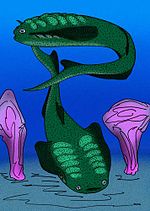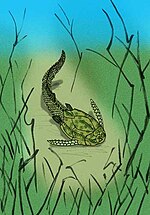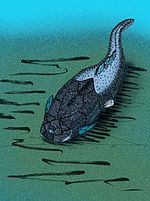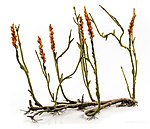Geological formation in Yunnan, China
The Xitun Formation is a palaeontological formation which is named after Xitun village in Qujing, a location in South China. This formation includes many remains of fossilized fish and plants of the Early Devonian period (Late Lochkovian).[1][2] It was originally referred to as the Xitun Member of the Cuifengshan Formation (now the Cuifengshan Group).[3]
Fossil content
|
|
|
|
Color key
|
|
Notes
Uncertain or tentative taxa are in small text; crossed out taxa are discredited.
|
Vertebrates
Acanthodians
| Acanthodians reported from the Xitun Formation
|
| Genus |
Species |
Presence
|
Material |
Notes |
Images
|
| Ischnacanthidae
|
Genus indet.
|
Qujing.[3]
|
4 isolated scales (V7218.1, 3, 6 & 8) & 2 longitudinal sections (V7218.4 & 7).[3]
|
Similar to Ischnacanthus & Acanthodes, may be referrable to Youngacanthus.
|
|
| Nostolepis
|
N. amplifica
|
Xitun, Xishan subdistrict, Qujing.[4]
|
43 trunk scales.[4]
|
|
|
| N. consueta
|
Xitun, Xishan subdistrict, Qujing.[4]
|
Around 25 trunk scales.[4]
|
|
|
| N. digitus
|
Xitun, Xishan subdistrict, Qujing.[4]
|
28 trunk scales.[4]
|
|
|
| N. qujingensis
|
Xitun, Xishan subdistrict, Qujing.[4]
|
19 trunk scales.[4]
|
|
|
| N. striata
|
Xitun, Xishan subdistrict, Qujing.[4]
|
69 trunk scales.[4]
|
|
|
| N. sp. indet.
|
Qujing.[3]
|
Body scales.[3]
|
|
|
| Youngacanthus
|
Y. gracilis
|
Qujing.[3]
|
Jaw elements & teeth.[3]
|
An ischnacanthid.
|
|
Actinopterygians
Arthropods
Chondrichthyes
Jawless fish
Placoderms
Sarcopterygians
Plants
See also
References
- ^ a b c d e f g h i j k l m n o p q r s t Zhu, Min (1996-01-01). "The phylogeny of the Antiarcha (Placodermi, Pisces), with the description of Early Devonian antiarchs from Qujing, Yunnan, China". Bull. Mus. Nat. Hist. Natur., Sér.
- ^ a b c d e f g h i j k Xue, Jinzhuang (March 2012). "Lochkovian plants from the Xitun Formation of Yunnan, China, and their palaeophytogeographical significance". Geological Magazine. 149 (2): 333–344. Bibcode:2012GeoM..149..333X. doi:10.1017/S001675681100077X. ISSN 0016-7568. S2CID 129280508.
- ^ a b c d e f g h i j k l m n o p q Wang, Nianzhong.; Wang, Nianzhong (1984). "Thelodont, acanthodian, and chondrichthyan fossils from the Lower Devonian of southwestern China". Proceedings of the Linnean Society of New South Wales. 107: 419–441. ISSN 0370-047X.
- ^ a b c d e f g h i j Li, Qiang; Cui, Xindong; Andreev, Plamen Stanislavov; Zhao, Wenjin; Wang, Jianhua; Peng, Lijian; Zhu, Min (2021-05-07). "Nostolepis scale remains (stem Chondrichthyes) from the Lower Devonian of Qujing, Yunnan, China". PeerJ. 9: e11093. doi:10.7717/peerj.11093. ISSN 2167-8359. PMC 8109008. PMID 34012725.
- ^ Zhu, Min. "Meemannia eos, a basal sarcopterygian fish from the Lower Devonian of China – expanded description and significance". Academia.
- ^ Lu, Jing; Giles, Sam; Friedman, Matt; den Blaauwen, Jan L.; Zhu, Min (2016-06-20). "The Oldest Actinopterygian Highlights the Cryptic Early History of the Hyperdiverse Ray-Finned Fishes". Current Biology. 26 (12): 1602–1608. doi:10.1016/j.cub.2016.04.045. ISSN 0960-9822. PMID 27212403. S2CID 3928790.
- ^ Ma, Z.; Lamsdell, J. C.; Wang, M.; Chen, J.; Selden, P. A.; He, B. (2024). "Early Devonian stylonurine eurypterids from northern Gondwana: Late Lochkovian to early Pragian records from South China". Gondwana Research. doi:10.1016/j.gr.2024.11.003.
- ^ a b Cui, Xindong; Qu, Qingming; Andreev, Plamen S.; Li, Qiang; Mai, Huijuan; Zhu, Min (2021-03-04). "Modeling scale morphogenesis in a Devonian chondrichthyan and scale growth patterns in crown gnathostomes". Journal of Vertebrate Paleontology. 41 (2): e1930018. Bibcode:2021JVPal..41E0018C. doi:10.1080/02724634.2021.1930018. ISSN 0272-4634. S2CID 237517966.
- ^ a b c d e f g h i j k l m n Xin-Dong, C. U. I.; Qiang, L. I.; Min, Z. H. U.; Min, Z. H. U. (2020-01-20). "New material of thelodonts from Lochkovian (Lower Devonian) of Qujing, Yunnan, China". Vertebrata PalAsiatica. 58 (1): 1. doi:10.19615/j.cnki.1000-3118.190612. ISSN 2096-9899.
- ^ a b Hao-Ran, Sun; Gai, Zhikun; Jia-Chen, Cai; Qiang, L I (April 2022). "Xitunaspis, a new eugaleaspid fish (Eugaleaspiformes, Galeaspida) from the Lower Devonian of Qujing, Yunnan". Vertebrata PalAsiatica. doi:10.19615/j.cnki.2096-9899.220412.
- ^ a b c Jun-Qing, Wang (1991-04-19). "Discovery of asterosteidae from Lower Devonian in Eastern Yuannan". Vertebrata PalAsiatica. 29 (2): 162. ISSN 2096-9899.
- ^ a b Dupret, V.; Zhu, M. (30 November 2007). "The earliest phyllolepid (Placodermi, Arthrodira) from the Late Lochkovian (Early Devonian) of Yunnan (South China)". Geological Magazine. 145 (2): 257–278. doi:10.1017/S0016756807004207. ISSN 1469-5081. S2CID 129360262.
- ^ Zhu, Min; Yu, Xiaobo; Choo, Brian; Wang, Junqing; Jia, Liantao (2012-06-23). "An antiarch placoderm shows that pelvic girdles arose at the root of jawed vertebrates". Biology Letters. 8 (3): 453–456. doi:10.1098/rsbl.2011.1033. PMC 3367742. PMID 22219394.
- ^ a b Wang, Yajing; Zhu, Min (2018-05-28). "Redescription of Phymolepis cuifengshanensis (Antiarcha: Yunnanolepididae) using high-resolution computed tomography and new insights into anatomical details of the endocranium in antiarchs". PeerJ. 6: e4808. doi:10.7717/peerj.4808. ISSN 2167-8359. PMC 5978403. PMID 29868260.
- ^ a b c d Dupret, Vincent; Zhu, Min; Wang, Jun-Qing (2017-03-04). "Redescription of Szelepis Liu, 1981 (Placodermi, Arthrodira), from the Lower Devonian of China". Journal of Vertebrate Paleontology. 37 (2): e1312422. Bibcode:2017JVPal..37E2422D. doi:10.1080/02724634.2017.1312422. ISSN 0272-4634. S2CID 90912807.
- ^ a b Zhu, Min; Yu, Xiaobo; Ahlberg, Per E. (2001). "A primitive sarcopterygian fish with an eyestalk". Nature. 410 (6824): 81–84. doi:10.1038/35065078. ISSN 0028-0836. PMID 11242045. S2CID 4416579.
- ^ a b Chang, Meemann; Yu, Xiaobo (January 1984). "Structure and phylogenetic significance of Diabolichthys speratus gen. et sp. nov., a new dipnoan-like form from the Lower Devonian of eastern Yunnan, China". Proceedings of the Linnean Society of New South Wales. 107 (3): 171–184.
- ^ Chang, Meemann (January 1995). "Diabolepis and its bearing on the relationships between porolepiforms and dipnoans". Bulletin du Muséum National d'Histoire Naturelle, Section C. 17 (1): 235–268.
- ^ a b Yu, Xiaobo (1998). "A New Porolepiform-Like Fish, Psarolepis romeri, gen. et sp. nov. (Sarcopterygii, Osteichthyes) from the Lower Devonian of Yunnan, China". Journal of Vertebrate Paleontology. 18 (2): 261–274. Bibcode:1998JVPal..18..261Y. doi:10.1080/02724634.1998.10011055. ISSN 0272-4634. JSTOR 4523897.
- ^ a b Zhu, Min; Yu, Xiaobo (September 2002). "A primitive fish close to the common ancestor of tetrapods and lungfish". Nature. 418 (6899): 767–770. Bibcode:2002Natur.418..767Z. doi:10.1038/nature00871. ISSN 1476-4687. PMID 12181564. S2CID 4389974.
- ^ Friedman, Matt (January 2007). "Styloichthys as the oldest coelacanth: Implications for early osteichthyan interrelationships". Journal of Systematic Palaeontology. 5 (3): 289–343. Bibcode:2007JSPal...5..289F. doi:10.1017/S1477201907002052. ISSN 1477-2019. S2CID 83712134.
- ^ Cui, Xindong; Friedman, Matt; Qiao, Tuo; Yu, Yilun; Zhu, Min (2022-05-02). "The rapid evolution of lungfish durophagy". Nature Communications. 13 (1): 2390. Bibcode:2022NatCo..13.2390C. doi:10.1038/s41467-022-30091-3. ISSN 2041-1723. PMC 9061808. PMID 35501345. S2CID 248504614.
- ^ a b Xue, Jinzhuang (2009-06-10). "Two Zosterophyll Plants from the Lower Devonian (Lochkovian) Xitun Formation of Northeastern Yunnan, China". Acta Geologica Sinica - English Edition. 83 (3): 504–512. Bibcode:2009AcGlS..83..504X. doi:10.1111/j.1755-6724.2009.00057.x. S2CID 131021391.
- ^ a b Hao, Shougang; Xue, Jinzhuang; Guo, Dali; Wang, Deming (January 2010). "Earliest rooting system and root : shoot ratio from a new Zosterophyllum plant". New Phytologist. 185 (1): 217–225. doi:10.1111/j.1469-8137.2009.03056.x. ISSN 0028-646X. PMID 19825018. S2CID 5638825.









